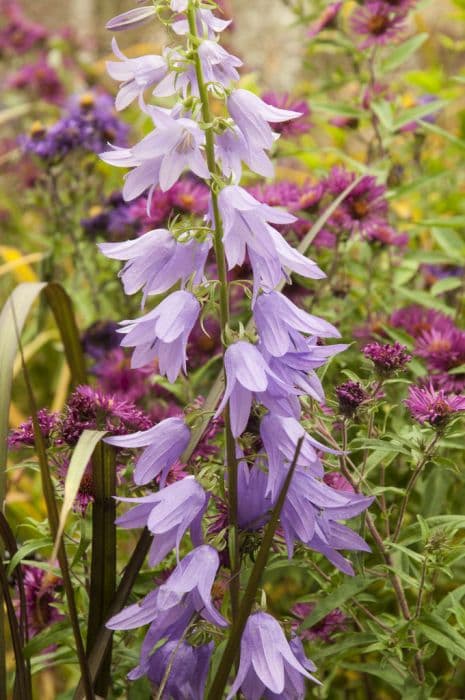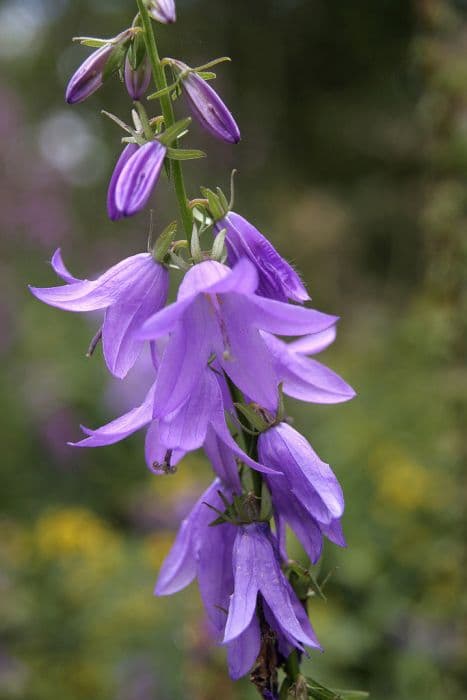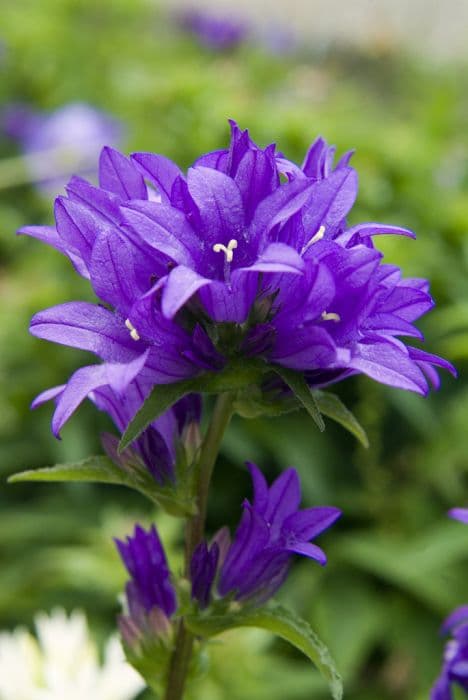Carpathian Bellflower Campanula carpatica 'Blaue Clips'

ABOUT
The Campanula carpatica 'Blaue Clips', commonly known as the Carpathian Harebell or the Carpathian Bellflower, is an eye-catching perennial with a mounded, low-growing habit. It is renowned for its abundance of charming, bell-shaped flowers that boast a radiant blue hue. These blooms are particularly noteworthy for their vibrant color and distinctive shape, being broad and open compared to other bellflowers. The foliage of this plant is lush and vibrant green. The leaves are heart-shaped with a somewhat toothed edge, forming a dense mound which serves as an attractive base for the striking flowers. The contrast between the green leaves and the blue flowers is visually striking and makes for a spectacular display in gardens. The flowers bloom profusely on short stalks that rise above the foliage, creating a delightful canopy of color. The bell-shaped flowers face upward or outward, rather than drooping, which gives a showy display, ensuring they catch the eye of passers-by as well as various pollinators such as bees and butterflies that are attracted to the plant. With its compact growth habit and floriferous nature, the Carpathian Harebell 'Blaue Clips' is an excellent choice for garden borders, rock gardens, and even as an ornamental addition to containers where its dazzling blue blooms can be admired up close.
About this plant
 Names
NamesFamily
Campanulaceae.
Synonyms
Carpathian Harebell, Carpathian Bellflower, Tussock Bellflower, Blue Clips Bellflower.
Common names
Campanula carpatica 'Blaue Clips'.
 Toxicity
ToxicityTo humans
Carpathian Bellflower, commonly known as Carpathian Harebell, is not known to be toxic to humans. This plant does not typically cause any symptoms of poisoning when touched or ingested.
To pets
Carpathian Bellflower, known to pet owners as Carpathian Harebell, is generally considered non-toxic to pets, including cats and dogs. Ingesting parts of this plant is unlikely to result in poisoning or adverse health consequences for pets.
 Characteristics
CharacteristicsLife cycle
Perennials
Foliage type
Deciduous
Color of leaves
Green
Flower color
Blue
Height
1 feet (30 cm)
Spread
2 feet (60 cm)
Plant type
Herb
Hardiness zones
3
Native area
Europe
Benefits
 General Benefits
General Benefits- Easy to grow – Campanula carpatica 'Blaue Clips' is a hardy plant that thrives in a range of soil types and climates, making it accessible for many gardeners.
- Attractive flowers – Produces a profusion of blue, bell-shaped flowers that enhance the visual appeal of any garden space.
- Long blooming period – Offers a prolonged flowering season from early summer to early fall, providing color for an extended period.
- Low maintenance – This variety of Campanula requires minimal care once established, needing only occasional watering and deadheading to thrive.
- Groundcover – Its dense growth habit makes it ideal for covering bare patches of soil and suppressing weeds.
- Edging plant – The compact nature and attractive foliage of 'Blaue Clips' make it perfect for edging paths and borders.
- Attracts pollinators – Blooms are attractive to bees and butterflies, promoting biodiversity in the garden.
- Rabbit resistant – Tends to be avoided by rabbits, reducing the risk of damage from wildlife.
 Medical Properties
Medical Properties- This plant is not used for medical purposes.
 Air-purifying Qualities
Air-purifying QualitiesThis plant is not specifically known for air purifying qualities.
 Other Uses
Other Uses- As a natural dye: The blossoms of the Carpathian Bellflower can provide a natural source of blue dye for fabrics and possibly art projects.
- In terrariums: Due to its compact size, the Carpathian Bellflower can be included in terrarium designs to add a touch of flowering beauty.
- In alpine and rock gardens: This species thrives in rocky conditions, making it a suitable ornamental addition to simulate alpine terrains in miniature garden settings.
- For border edgings: The low-growing habit and abundant blooming nature of the Carpathian Bellflower make it an excellent choice for creating attractive border edges in gardens.
- As companion plants: They can be paired with other perennials in garden beds to complement different blooming seasons and leaf textures.
- For early pollen sources: These plants can serve as a source of early-season pollen for bees and other beneficial insects, supporting local ecosystems.
- In fairy gardens: With their charming flowers, these plants can be ideal for integrating into fairy garden designs by imaginative gardeners.
- As photography subjects: The vivid blue flowers of the Carpathian Bellflower can be compelling subjects for macro photography and nature inspiration.
- In wedding decorations: Fresh or dried, the Carpathian Bellflower can be incorporated into bridal bouquets or table arrangements for a rustic floral theme.
- For educational purposes: Due to its ease of growth, this plant can be used in educational settings to teach children about plant biology and gardening basics.
Interesting Facts
 Feng Shui
Feng ShuiThe Carpathian Bellflower is not used in Feng Shui practice.
 Zodiac Sign Compitability
Zodiac Sign CompitabilityThe Carpathian Bellflower is not used in astrology practice.
 Plant Symbolism
Plant Symbolism- Constancy and Perseverance: Campanula carpatica, commonly known as Carpathian Bellflower, often symbolizes constancy and perseverance due to its habit of growing in harsh mountainous conditions and its ability to return every year with robust blooms.
- Gratitude: The bell-shaped flowers can also be a symbol of gratitude, representing the act of 'ringing' thanks towards someone for their kindness and love.
- Unwavering Love: In the language of flowers, bellflowers are sometimes associated with unwavering love and affection, akin to the steadfast nature of their blooms.
- Humility: The way the blooms tend to face downward has led to their association with humility, symbolizing modesty and a down-to-earth nature.
- Hope: Their ability to grow in challenging environments makes them a symbol of hope, suggesting resilience in the face of adversity.
 Water
WaterThe Carpathian Bellflower should be watered thoroughly, ensuring the soil is moist but not waterlogged. Water the plant when the top inch of soil feels dry to the touch, which could be once or twice a week depending on the climate conditions. Less frequent watering is required during the dormant winter season, possibly reducing to once every two weeks. Each watering session should provide enough water to saturate the root zone, which may approximately be about one gallon for mature plants, adjusted as needed for smaller or larger specimens. Make sure to avoid overhead watering to prevent leaf diseases; direct the water to the base of the plant instead.
 Light
LightCarpathian Bellflower thrives in full sun to partial shade. The ideal spot for this plant would be an area where it can receive at least 6 hours of sunlight daily, although it can tolerate some afternoon shade in particularly hot climates. Avoid deeply shaded areas as this can lead to leggy plants and fewer flowers.
 Temperature
TemperatureCarpathian Bellflower prefers moderate temperature conditions and can generally tolerate temperature ranges between 50°F and 85°F. Temperature extremes should be avoided, as the plant can struggle in conditions below 50°F or above 85°F. The ideal temperature range for promoting healthy growth and flowering is between 60°F and 75°F.
 Pruning
PruningPrune the Carpathian Bellflower to remove spent flowers and encourage a second bloom. Deadheading the faded blooms throughout the blooming season can promote healthier plants and more flowers. After the first flush of flowering, cut back the plant by up to one-third to refresh the foliage and set new buds. The best time for more extensive pruning is immediately after flowering has declined.
 Cleaning
CleaningAs needed
 Soil
SoilCarpathian Bellflower thrives in well-draining soil with a mixture of loam, peat, and sand, with a pH range of 6.0 to 8.0 for optimal growth. Soil should retain moisture but not become waterlogged.
 Repotting
RepottingCarpathian Bellflower typically does not require frequent repotting and can be done every 2-3 years or when it outgrows its current container, to refresh soil and encourage healthy growth.
 Humidity & Misting
Humidity & MistingCarpathian Bellflower prefers moderate humidity levels but is adaptable to a range of conditions, not requiring specific humidity adjustments when grown indoors or outdoors.
 Suitable locations
Suitable locationsIndoor
Provide bright indirect light, water when topsoil is dry.
Outdoor
Plant in partial shade, ensure soil drainage, protect from harsh sun.
Hardiness zone
3-9 USDA
 Life cycle
Life cycleThe Carpathian Bellflower 'Blaue Clips' begins its life cycle when seeds are sown in spring after the threat of frost has passed. Germination occurs over several weeks, and the seedlings develop true leaves and a root system. The juvenile plants grow throughout the summer, forming a rosette of foliage at ground level. By the next growing season, they mature and produce stems with clusters of vibrant blue, bell-shaped flowers. After blooming, which generally lasts from early to late summer, the plant sets seeds which can be dispersed around the parent plant. In the fall, the plant enters dormancy, with the foliage dying back, and remains dormant through winter until the cycle starts anew with the next warm season.
 Propogation
PropogationPropogation time
Spring-Summer
The Carpathian Bellflower 'Blaue Clips' is typically propagated by seed or by division. The most popular method for this plant is often propagation by division, which is best done in the spring or early fall. To divide, carefully lift the entire plant from the ground with a garden fork, ensuring you cause as little damage as possible to the root system. Gently tease apart the plant into smaller sections, making sure that each section has a portion of the roots and a few shoots. These sections can then be replanted into well-prepared soil, spaced about 12 inches (approximately 30 centimeters) apart to allow for adequate growth and air circulation. Water thoroughly after planting to encourage the roots to establish in their new location. With proper care, these divisions will grow and can flower in the same season.








